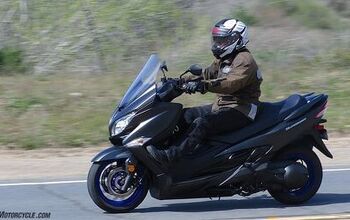2021 Ducati Multistrada V4 Begins Production With Bosch Radar System

Ducati claims industry-first front and rear radar technology
Ducati announced that production of the Multistrada V4 has already begun at its factory in Borgo Panigale, Italy, while claiming that the adventure-tourer will be the world’s first production motorcycle equipped with front and rear radar technology.
Ducati also confirmed in a press release (published in full, below) that the Multistrada will use a new “light and compact” V-Four engine. Ducati says the new engine was designed for “‘adventouring’ use without neglecting emotion and sportiness,” but perhaps more practically, “record-breaking maintenance intervals.” As a model intended to chew up a lot of miles, far more than the Panigale V4 or Streetfighter V4, being able to go longer between maintenance intervals will be a big plus.
The timing of the announcement is a little odd, considering Ducati is in the midst of a four-part teaser campaign for the 2021 Multistrada V4 which hadn’t even mentioned the radar technology yet. Of course, Ducati had already announced back in 2018 that the it was working on a motorcycle radar system. Ducati also took the unusual step in today’s press release to link to that earlier one (we’ve removed it from the release below, as it requires press credentials to access). In other words, Ducati seems really, really, intent on being able to say it is the first to offer the technology on a motorcycle. Almost as if Ducati expects one of its competitors to announce something today…
The radar system, developed by Bosch, uses radar units installed in the front and rear of a motorcycle to allow for adaptive cruise control and blind spot detection, systems that are now common-place in automobiles but only now being adapted for motorcycles.
The front radar unit (housed below the headlight on the Multistrada V4) scans for traffic and automatically adjusts braking and acceleration to maintain a preset separation distance when riding at speeds between 30 and 160 kph (19 to 99 mph). The adjustments will be controlled and not abrupt, allowing the rider to maintain control as needed.
The rear radar will monitor the Multistrada’s blind spots, alerting the rider of vehicles approaching from behind at high speeds.
Ducati isn’t the only company planning to use the radar technology. BMW confirmed in June it would introduce the Bosch radar system on a future model, as did KTM back in 2018. Neither BMW or KTM has formally announced a new model equipped with the front and rear radar system, but both made it clear the technology is coming this year.
Ducati says the 2021 Multistrada V4 will be announced on Nov. 4, while details about its engine will be revealed on Oct. 15. Today’s announcement, then, seems intent on establishing the Multistrada V4 as being the first production bike to introduce the technology.
Begin Press Release
Ducati announces the entry into production of the world’s first motorcycle equipped with front and rear radar technology: the new Multistrada V4
- Production of the Multistrada V4 begins, the fourth generation of one of the most successful motorcycles of the Bologna-based company, already produced in more than 110,000 units
- The bike is equipped with a completely new V4 engine developed for maximum smoothness of operation and a substantial extension of maintenance intervals
- The Multistrada V4 is the first motorcycle in the world equipped with front and rear radar capable of providing the user with a revolutionary riding aid system
Production of the Multistrada V4 has begun at the Ducati factory in Borgo Panigale: the first motorcycle to use front and rear radar technology. The Multistrada V4 marks an epochal turning point for the Bologna-based motorcycle manufacturer and will be officially presented on 4 November.
For the fourth generation of the Multistrada, Ducati has developed a new, light and compact V4 engine, designed to meet the needs required for “adventouring” use without neglecting emotion and sportiness. The complete redesign made it possible to reach record-breaking maintenance intervals for the world of two wheels. All the details of this new engine will be revealed on 15 October.
Ducati brings radars on production bikes, confirming what was anticipated in 2018 (link to the press release of April 2018 here). The adoption of these systems promises to be a true revolution for the world of two wheels, marking a new level of excellence in terms of comfort and riding assistance, especially on long motorway journeys.
Radars are advanced aid systems capable of supporting and making riding more comfortable thanks to the ability to reconstruct the reality surrounding the motorcycle. Ducati’s interest in this type of systems dates back to 2016, when the Company worked in collaboration with the Department of Electronics, Information and Bioengineering of the Politecnico di Milano to experiment with this type of systems. This first experience has confirmed the applicability of this kind of technology to vehicles on two wheels, and has pushed Ducati to the creation of a complete package of riding assistance using two radars that, within four years, has been developed and produced in close cooperation with Bosch, a top-level technology partner, and sees its first application on the new Multistrada V4.
Each radar has compact dimensions (70 x 60 x 28 mm, similar to a modern action camera) and integrates perfectly into the bike, weighing only 190 grams.
The radar positioned in the front of the vehicle controls the operation of the ACC (Adaptive Cruise Control), which by means of controlled braking and acceleration automatically adjusts the distance (selectable on four levels) from other vehicles when riding at a speed between 30 and 160 km/h. This car-derived system has been evolved and developed according to the dynamics and ergonomics of a two-wheeled vehicle. In particular, the authority of the system in terms of deceleration and acceleration has been limited in order to ensure the rider can maintain constant control of the vehicle in any situation. The system allows for more comfortable riding, especially on long motorway journeys.
The rear radar, on the other hand, is able to detect and report vehicles positioned in the so-called blind spot, i.e. the area not visible either directly by the rider or through the rear-view mirror. The BSD (Blind Spot Detection) system also signals the approaching from behind of vehicles at high speed.
To underline the technical-scientific value of the research project, carried out jointly by Ducati engineers and researchers and undergraduates from the Politecnico di Milano, a patent application relating to the control algorithms of this system was filed in May 2017. In June 2017, a scientific publication was presented at the IEEE – Intelligent Vehicles Symposium (IV) in Redondo Beach, California.
Become a Motorcycle.com insider. Get the latest motorcycle news first by subscribing to our newsletter here.

Dennis has been a part of the Motorcycle.com team since 2008, and through his tenure, has developed a firm grasp of industry trends, and a solid sense of what's to come. A bloodhound when it comes to tracking information on new motorcycles, if there's a new model on the horizon, you'll probably hear about it from him first.
More by Dennis Chung




































Comments
Join the conversation
Goodbye lane sharing.
If you drop the bike, how much to re-calibrate? Just like windshield replacements costing $1000+ for a crack in a car, this one's gonna cost ya. ABS, traction control and IMU's make more sense, this is just fluff you don't need.